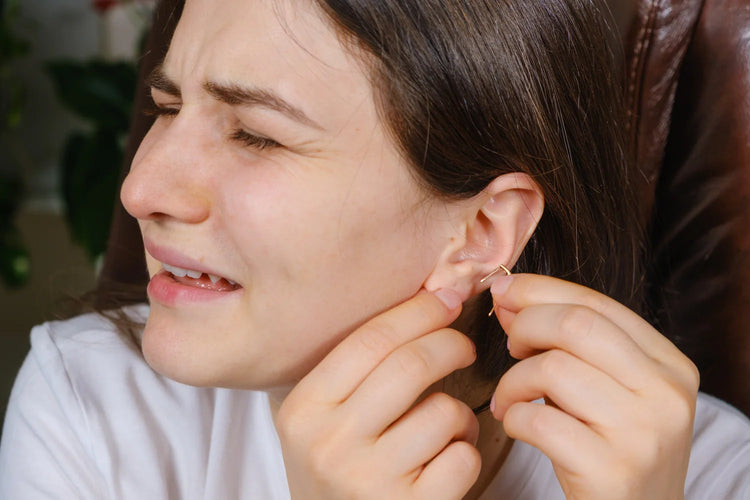The earlobe piercing pain scale tends to vary depending on personal experience. The level of intensity is relatively mild compared to other types of piercing. In fact, according to professionals, earlobe piercings typically sit at a solid 4 out of 10 on the pain scale.
It can vary greatly among different people, depending on their pain threshold, anxiety levels, and the skill of the piercer. This scale can help people manage their expectations and make informed decisions about getting pierced.
In this blog post, we'll delve deeper into the world of earlobe piercing pain, taking a closer look at why it is so low on the scale and how you can manage any discomfort during and after the piercing process.
Earlobe Piercing Pain Scale: 5 Factors Affecting

Although the procedure is generally considered safe and low-risk, many individuals report varying pain levels. Many factors can affect pain, including equipment, skill, and experience of the piercer.
Different Pain Thresholds For Individuals
The pain threshold is the level of pain that someone can tolerate before it becomes unbearable. Many factors, such as genetics, age, gender, and previous experiences with pain, influence it.
People who have a lower pain threshold may find piercings less painful, while others who are sensitive may find them more painful. The earlobe piercing pain scale must consider this.

Use Of Numbing Cream Or Ice To Reduce Pain
Some piercers may offer a numbing cream or ice to reduce earlobe pain. Numbing agents work by numbing the skin's nerve endings, which can reduce the piercing's pain. Ice cools the skin, diminishing its pain sensitivity. Follow instructions carefully.
Pierce's Anxiety Levels Before And During The Procedure
Anxiety and fear can significantly contribute to a higher earlobe piercing pain scale. Pain may be more intense for people who are anxious or stressed before or during the procedure. The piercer should be communicated with beforehand about any concerns or anxieties.
Experience And Technique Of The Piercer

When it comes to the experience and technique of a piercer, there are a few key factors to consider. Firstly, a skilled piercer should deeply understand materials and their properties, as different metals will require different piercing techniques to achieve the desired results.
A piercer should possess advanced knowledge of general metal forging and how piercing fits into the overall forging process.
The piercer can then make an informed decision about how much piercing is necessary for a given part. A master piercer can combine practical considerations with an artistic eye, creating a technically sound and visually appealing product. Aftercare is recommended to minimize bleeding, infection, and allergy risks.
Individual Pain Tolerance
Individual pain tolerance is important for piercers when administering a standard lobe piercing. Pain thresholds are lower in adults than in children, who usually handle pain better. Many adults find the pain more intense, especially if they have never been pierced.
A piercer must take a holistic approach and consider individual pain tolerance when piercing a lobe. This includes educating the client on what to expect and creating a comfortable environment to minimize pain and anxiety. By doing so, piercers can ensure their clients have a more pleasant and successful piercing experience.
During And After Lobe Piercing: 4 Pain Management

When it comes to managing pain during and after lobe piercings, several strategies can be employed. One option is to utilize topical anesthetic creams or sprays. As these products numb the skin and nerves in the area, piercings become more comfortable and painless.
Topical Anesthetic Creams Or Sprays
Topical anesthetic creams or sprays are commonly used for pain management during earlobe piercing. Pain levels vary depending on the anesthetic type, dosage, and individual pain tolerance. Topical anesthetic creams or sprays can reduce the pain from 10 to 2 on a pain scale of 1 to 10.
Ice Packs To Numb The Earlobe
Another pain management strategy that can be used during earlobe piercing is the application of ice packs to the earlobe. Ice packs work by numbing the area and reducing inflammation, which can help to minimize pain during the piercing. Ice pack therapy is generally used with other pain management strategies, such as topical anesthetic creams or sprays. A pain level of 2 to 4 is experienced during and after piercing when using ice packs.
Acetaminophen Or Ibuprofen For Pain Relief
Over-the-counter pain relievers like acetaminophen and ibuprofen are commonly used during and after earlobe piercing. These drugs can reduce pain and inflammation, making healing more comfortable. A pain level of 3 to 6 can be achieved using acetaminophen or ibuprofen.

Proper Aftercare To Reduce Discomfort And Inflammation
Proper aftercare is crucial for managing pain during and after earlobe piercing. Following the piercer's aftercare instructions can minimize discomfort and inflammation, reducing pain levels.
Aftercare instructions usually include cleaning the pierced area regularly, avoiding touching it with dirty hands and avoiding activities that may irritate it.
Various factors affect earlobe piercing pain levels, including individual pain tolerance. Anesthetic creams and sprays, ice packs, pain relievers, and proper aftercare can reduce pain levels, making the healing process more comfortable.
Comparison To Other Piercings
Compared to other piercings, the standard lobe piercing is considered one of the least painful. The earlobe contains fewer nerves than other areas of the body where piercings can be done because it is fleshy. Therefore, the pain is described as momentary or only as a pinch.
Lobe Piercing Compared To Cartilage Piercings Or Nipple Piercings
Earlobe piercings are often considered the least painful type of piercing. Compared to cartilage or nipple piercings, earlobe piercing typically ranks lower on the pain scale.
Cartilage piercings, in particular, tend to be more painful due to the thickness of the cartilage. A piercing at the nipple can also be painful because of the area's sensitivity.
One reason why earlobe piercings are less painful is due to the amount of nerve endings in the earlobe. The nerve endings in the lobe are less dense than other body areas, making the piercing less painful overall.
Anecdotes Or Survey Results On Pain Scale Variation

According to a survey by the Association of Professional Piercers, the average pain rating for an earlobe piercing is 4 out of 10. Depending on individual pain tolerance and piercing method, pain levels can vary.
Many people with earlobe piercings report sharp, intense pain during the piercing process. The pain typically subsides quickly once the piercing is complete. Some people may experience ongoing pain or discomfort during the healing process.
While earlobe piercings might not be completely painless, they're among the least painful. The right aftercare can speed healing and minimize discomfort from earlobe piercings.
Conclusion
In conclusion, earlobe piercing is generally considered less painful than other piercings. Factors such as needle gauge, technique, and individual pain tolerance can impact the pain level.
Choosing a reputable piercer is crucial to minimize pain and discomfort, as following aftercare instructions and mentally preparing for the procedure. By understanding the factors that affect the earlobe piercing pain scale, one can make informed decisions and enjoy their piercing experience.

